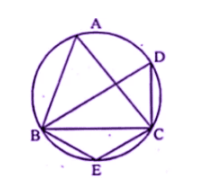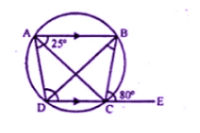
(b) In the figure (if) given below, AB is parallel to DC, ∠BCE = 80° and ∠BAC = 25°. Find:
(i) ∠CAD (ii) ∠CBD (iii) ∠ADC (2008)

Solution:
(a) ∠DBC = 58°
BD is diameter
∠DCB = 90° (Angle in semi-circle)
(i) In ∆BDC
∠BDC + ∠DCB + ∠CBD = 180°
∠BDC = 180°- 90° – 58° = 32°
(i) In ∆BDC
∠BDC + ∠DCB + ∠CBD = 180°
∠BDC = 180°- 90° – 58° = 32°
(ii) BEC = 180o – 32o = 148o
(opposite angles of cyclic quadrilateral)
(iii) ∠BAC = ∠BDC = 32o
(Angles in same segment)
(b) in the figure, AB ∥DC
∠BCE = 80o and ∠BAC = 25o
ABCD is a cyclic Quadrilateral and DC is
Production to E
(i) Ext, ∠BCE = interior ∠A
80o = ∠BAC + ∠CAD
80o = 25o + ∠CAD
∠CAD = 80o – 25o = 55o
(ii) But ∠CAD = ∠CBD
(Alternate angels)
∠CBD = 55o
(iii) ∠BAC = ∠BDC
(Angles in the same segments)
∠BDC = 25o
(∠BAC = 25o)
Now AB ∥ DC and BD is the transversal
∠BDC = ∠ABD
∠ABD = 25o
∠ABC = ∠ABD + ∠CBD = 25o + 55o = 80o
But ∠ABC + ∠ADC = 180o
(opposite angles of a cyclic quadrilateral)
80o + ∠ADC = 180o
∠ADC = 180o – 80o = 100o
